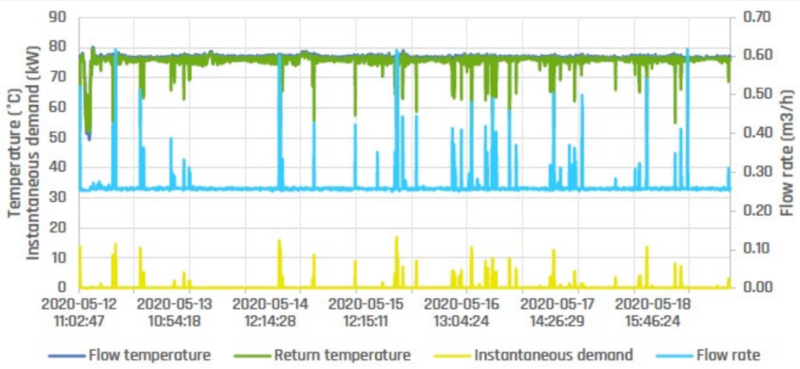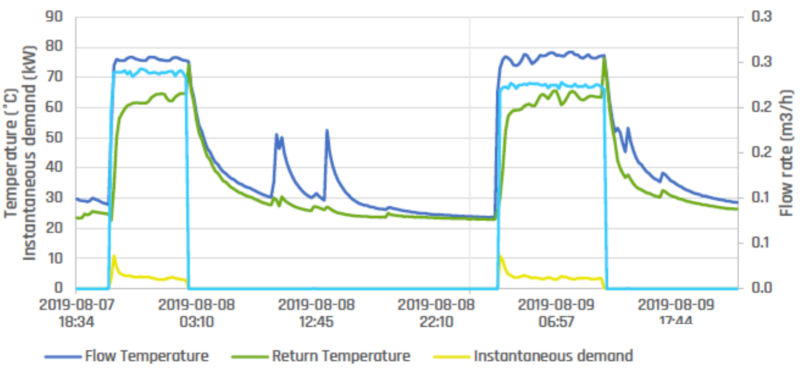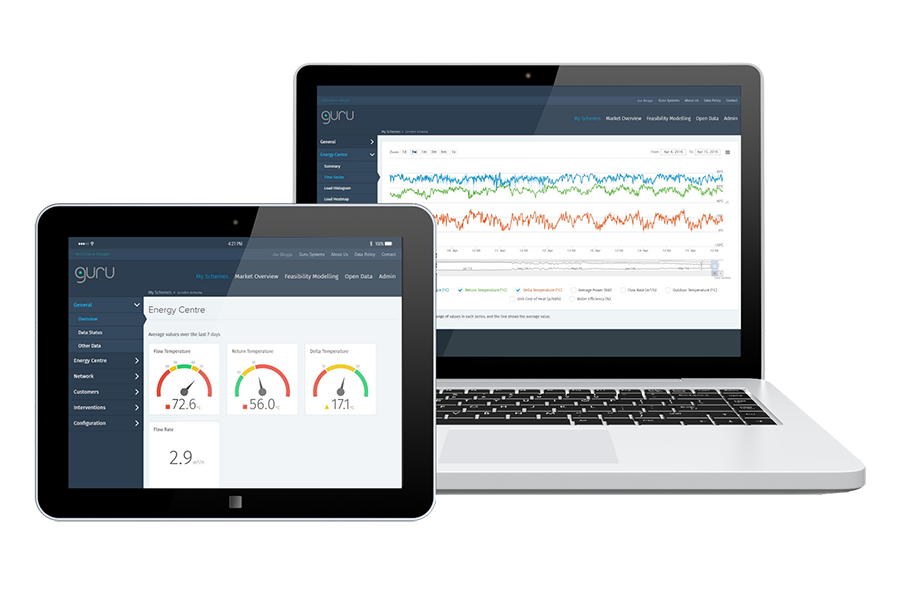Throughout 2020, heat networks consultancy FairHeat used Guru Pinpoint to analyse ten existing heat networks as part of a project for the Heat Network Optimisation Opportunities programme funded by the Department for Business, Energy & Industrial Strategy (BEIS).
Guru Pinpoint is an online analytics platform which gives developers, operators, and engineers access to the real-time performance data being collected by Guru Systems’ hardware installed across heat networks. The platform uses machine learning algorithms to help identify and resolve performance issues and improve the efficiency of the heat network.
FairHeat considered a variety of performance and reliability indicators before suggesting a series of costed improvement projects that would reduce heat losses (and therefore both costs and carbon emissions) across the network.
If the identified problems were then to be fixed, modelling work showed that heat losses would be reduced by an average of 40-50%, representing a cost saving of between £75 and £160 per dwelling.
These findings match a previous study conducted by Guru Systems and FairHeat which delivered improvements at Stockwell Park Estate in London reducing heat network losses by 53% and saving residents £140 per year.
Why heat network performance is important
Heat networks are a fundamental part of the UK’s decarbonisation strategy. The Committee on Climate Change expects the proportion of UK heating delivered over heat networks to rise from 2% to at least 20% by 2050.
However, many heat networks do not perform anywhere near their intended efficiency, with work carried out by Guru Systems for BEIS finding that on average many only deliver 36% of input energy to dwellings as useful heat, against design efficiencies of more than 80%.
Inefficient heat networks are also more expensive to run. For a heat network operator, an inefficient network makes for higher fuel costs, and increased maintenance costs and call outs.
For a resident, living on an inefficient network likely means more expensive bills as well as day to day problems like overly warm communal spaces and corridors.
The project
FairHeat analysed ten heat networks built between 1970 and 2019 – nine district heating networks and one communal heat network. The size of each network varied between 74 and 950 dwellings – and a total of 3,232 dwellings were included. Seven of the ten networks were run by housing associations.
Data was collected from a variety of sources, including the heat network performance data from Guru Pinpoint on nine of the ten sites, as well as data from BMS systems, maintenance logs and stakeholder interviews.
Guru Pinpoint displayed performance indicators such as network flow temperature, network heat losses, network return temperatures and dwelling return temperatures. This information could also be used to calculate heat generation efficiency.
Reliability indicators were also considered, such as the time the network spent below a minimum flow temperature and the stability of the flow temperature were also considered, as well as major outages, interruptions and maintenance frequency.
Proposed interventions
Using the data collected, FairHeat were able to suggest a variety of interventions.
The most common intervention works that were deemed both financially and technically viable included:
- Recommissioning Heat Interface Units (HIUs) and heating systems e.g. radiators within dwellings
- Closing network bypasses
- Reinsulating sections of the pipework within the dwelling and network
- Improving plant room controls including the pumps
- Hydraulic rearrangements
- Improving water quality
As well as heat loss reductions of 40-50%, proposed interventions had a modelled payback period of 0.4 and 7 years, with six of the schemes having a simple payback of less than 5 years.
FairHeat also note that a carbon emissions reduction of over 30% was possible through optimisation alone, without the need for any major equipment replacement.
You can’t manage what you don’t measure
A key takeaway from the project was the importance of capturing performance and reliability data in the first place.
While some BMS systems give an overview of a plant room or energy centre, having access to data from block level meters and individual dwellings is the best way to spot many problems. Interventions such as HIU recommissioning, adjusting radiators, and closing network bypasses would not be possible without information from each dwelling.
Collecting data at regular intervals is also important. Guru Pinpoint displays data every five minutes. This allows you to attribute readings to different load types e.g. domestic hot water more reliably allowing further issues to be caught.
Guru Pinpoint displays captured data


Guru Pinpoint shows bypassing HIUs that require recommissioning


Thermal imaging and Guru Pinpoint together show radiators that have high return temperatures and high levels of water passing through them during heating.
Data visibility drives good network performance
Even where networks are well-designed and properly commissioned before residents move in, heat networks are often left to drift, with performance degrading over time.
This is often not due to a fault in equipment, but rather is due to the accumulation of many small changes in the system over time, for example maintenance engineers changing one part of a heat network without regard to the effect on the whole.
This was clear in FairHeat’s analysis, especially as some of the heat networks included in the project had been built relatively recently. When unwatched, new networks are not naturally better than old networks.
Access to detailed data for site-wide diagnostics allows problems or inefficiencies to be identified, reducing total energy costs. It can also point maintenance engineers in the right direction, reducing the time spent investigating problems on site.

